
Multituberculata is an extinct order of rodent-like mammals with a fossil record spanning over 130 million years. They first appeared in the Middle Jurassic, and reached a peak diversity during the Late Cretaceous and Paleocene. They eventually declined from the mid Paleocene onwards, disappearing from the known fossil record in the late Eocene. They are the most diverse order of Mesozoic mammals with more than 200 species known, ranging from mouse-sized to beaver-sized. These species occupied a diversity of ecological niches, ranging from burrow-dwelling to squirrel-like arborealism to jerboa-like hoppers. Multituberculates are usually placed as crown mammals outside either of the two main groups of living mammals—Theria, including placentals and marsupials, and Monotremata—but usually as closer to Theria than to monotremes. They are considered to be closely related to Euharamiyida and Gondwanatheria as part of Allotheria.
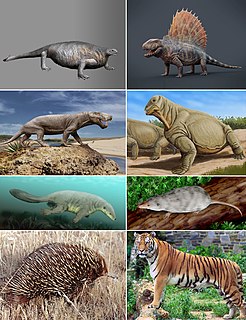
Synapsids are one of the two major groups of animals that evolved from basal amniotes, the other being the sauropsids, the group that includes reptiles and birds. The group includes mammals and every animal more closely related to mammals than to sauropsids. Unlike other amniotes, synapsids have a temporal fenestra, an opening low in the skull roof behind each eye orbit, leaving a bony arch beneath each; this accounts for their name. The distinctive temporal fenestra developed about 318 million years ago during the Late Carboniferous period, when synapsids and sauropsids diverged, but was subsequently merged with the orbit in early mammals.

Therapsida is a major group of eupelycosaurian synapsids that includes mammals, their ancestors and relatives. Many of the traits today seen as unique to mammals had their origin within early therapsids, including limbs that were oriented more underneath the body, as opposed to the sprawling posture of many reptiles and salamanders.
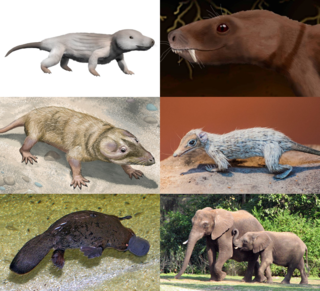
The cynodonts are a clade of eutheriodont therapsids that first appeared in the Late Permian, and extensively diversified after the Permian–Triassic extinction event. Cynodonts had a wide variety of lifestyles, including carnivory and herbivory. Mammals are cynodonts, as are their extinct ancestors and close relatives, having evolved from advanced probainognathian cynodonts during the Late Triassic. All other cynodont lines went extinct, with the last known non-mammalian cynodont group, the Tritylodontidae, having its youngest records in the Early Cretaceous.
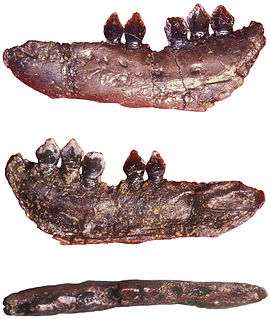
Echinodon is a genus of heterodontosaurid dinosaur that lived during the earliest Cretaceous of southern England and possibly western France in the Berriasian epoch. The first specimens were jaw bones named Echinodon becklesii by Sir Richard Owen in 1861, and since their original description only additional teeth have been discovered. The specific name honours collector Samuel Beckles who discovered the material of Echinodon and many other taxa from across England, while the genus name translates as "prickly tooth" in reference to the dental anatomy of the taxon.

Symmetrodonta is a group of Mesozoic mammals and mammal-like synapsids characterized by the triangular aspect of the molars when viewed from above, and the absence of a well-developed talonid. The traditional group of 'symmetrodonts' ranges in age from the latest Triassic to the Late Cretaceous, but most research in the last 20-30 years has concluded that they are not a true taxonomic group, but include several unrelated branches of the mammal tree. Despite this, the name is still used informally by some researchers for convenience, usually restricted to the spalacotheriids and zhangheotheriids.
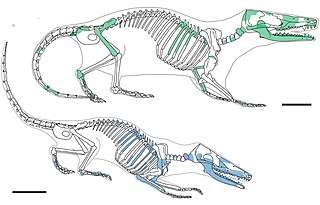
Docodonta is an order of extinct mammaliaforms that lived during the Mesozoic, from the Middle Jurassic to Early Cretaceous. They are distinguished from other early mammaliaforms by their relatively complex molar teeth, from which the order gets its name. Until recently, Docodonta were represented primarily by teeth and jaws found across former Laurasia,. However, recent discoveries in China include some exceptionally well preserved, almost complete body fossils.
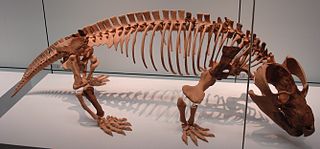
Probainognathia is one of the two major subgroups of the clade Eucynodontia, the other being Cynognathia. The earliest forms were carnivorous and insectivorous, though some groups eventually also evolved herbivorous diets. The earliest and most basal probainognathian is the Middle Triassic (Anisian) aged Lumkuia, from South Africa, though probainognathians would not become prominent until the mid Norian stage of the Late Triassic. Three groups survived the extinction at the end of Triassic: Tritheledontidae and Tritylodontidae, which both survived until the Jurassic—the latter even into the Cretaceous —and Mammaliaformes, which includes the mammals.
Tritylodontidae is an extinct family of small to medium-sized, highly specialized mammal-like cynodonts, bearing several mammalian traits like erect limbs, endothermy and details of the skeleton. They were the last-known family of the non-mammaliaform synapsids, persisting into the Early Cretaceous.

Tritheledontidae, the tritheledontids or ictidosaurs, is an extinct family of small to medium-sized cynodonts. They were highly mammal-like, specialized cynodonts, although they still retained a few reptile-like anatomical traits. Tritheledontids were mainly carnivorous or insectivorous, though some species may have developed omnivory. Their skeletons show that they had a close relationship to mammals. Tritheledontids or their closest relatives may have given rise to the mammaliaforms. The tritheledontids were one of the longest lived non-mammalian therapsid lineages, living from the late Triassic to the Jurassic period. Tritheledontids became extinct in the Jurassic period, possibly due to competition with prehistoric mammals such as the eutriconodonts. They are known from finds in South America and South Africa, indicating that they may have lived only on the supercontinent of Gondwana. The family Tritheledontidae was named by South African paleontologist Robert Broom in 1912. The family is often misspelled "Trithelodontidae".

Docodon was a mammaliaform from the Late Jurassic of western North America. It was the first docodontan cynodont to be named.

The evolution of mammals has passed through many stages since the first appearance of their synapsid ancestors in the Pennsylvanian sub-period of the late Carboniferous period. By the mid-Triassic, there were many synapsid species that looked like mammals. The lineage leading to today's mammals split up in the Jurassic; synapsids from this period include Dryolestes, more closely related to extant placentals and marsupials than to monotremes, as well as Ambondro, more closely related to monotremes. Later on, the eutherian and metatherian lineages separated; the metatherians are the animals more closely related to the marsupials, while the eutherians are those more closely related to the placentals. Since Juramaia, the earliest known eutherian, lived 160 million years ago in the Jurassic, this divergence must have occurred in the same period.

Eutriconodonta is an order of early mammals. Eutriconodonts existed in Asia, Africa, Europe, North and South America during the Jurassic and the Cretaceous periods. The order was named by Kermack et al. in 1973 as a replacement name for the paraphyletic Triconodonta.
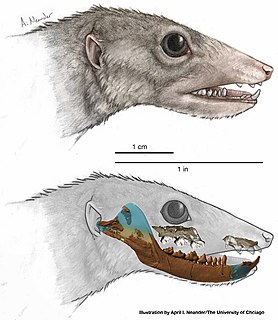
Haramiyida is a possibly polyphyletic order of mammaliaform cynodonts or mammals of controversial taxonomic affinites. Their teeth, which are by far the most common remains, resemble those of the multituberculates. However, based on Haramiyavia, the jaw is less derived; and at the level of evolution of earlier basal mammals like Morganucodon and Kuehneotherium, with a groove for ear ossicles on the dentary. If they are early multituberculates, they would be the longest lived mammalian clade of all time. However, a more recent study, in November 2015, may dispute this and suggested the Haramiyida were not crown mammals, but were part of an earlier offshoot of mammaliaformes instead. It is also disputed whether the Late Triassic species are closely related to the Jurassic and Cretaceous members belonging to Euharamiyida/Eleutherodontida, as some phylogenetic studes recover the two groups as unrelated, recovering the Triassic haramiyidians as non-mammalian cynodonts, while recovering the Euharamiyida as crown-group mammals closely related to multituberculates.

Dryolestida is an extinct order of mammals; most of the members are mostly known from the Jurassic and Cretaceous. They are considered members of the clade Cladotheria, close to the ancestry of therian mammals. It is also believed that they developed a fully mammalian jaw and also had the three middle ear bones. Most members of the group, as with most Mesozoic mammals, are only known from fragmentary tooth and jaw remains.
Tinodontidae is an extinct family of actively mobile mammal, endemic to what would now be North America, Asia, Europe, and Africa during the Jurassic and Cretaceous periods.

Eutheriodontia is a clade of therapsids which appear during the Middle Permian and which includes therocephalians and cynodonts, this latter group including mammals and related forms.

Necrolestes is an extinct genus of mammals, which lived during the Early Miocene in what is now Argentine Patagonia. It is the most recent known genus of Meridiolestida, an extinct group of mammals more closely related to therians than to monotremes that dominated South America during the Late Cretaceous. It contains two species, N. patagonensis and N. mirabilis, The type species N. patagonensis was named by Florentino Ameghino in 1891 based on remains found by his brother, Carlos Ameghino in Patagonia. Fossils of Necrolestes have been found in the Sarmiento and Santa Cruz Formations.
Alticonodon is a genus of extinct mammal from the Late Cretaceous of North America. It is the geologically youngest known eutriconodont, and is a fairly more specialised animal than earlier representatives of this clade.

Meridiolestida is an extinct clade of mammals known from the Cretaceous and Cenozoic of South America and possibly Antarctica. They represented the dominant group of mammals in South America during the Late Cretaceous. Meridiolestidans were morphologically diverse, containing both small insectivores such as the "sabretooth-squirrel" Cronopio, as well as the clade Mesungulatoidea/Mesungulatomorpha, which ranged in size from the shrew-sized Reigitherium to the dog-sized Peligrotherium. Mesungulatoideans had highly modified dentition with bunodont teeth, and were likely herbivores/omnivores.






















